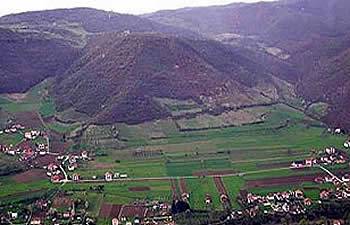One of the things I have picked up along my spiritual path so far is the celebration of the ancient sacred days. While most people would identify them with (neo)pagan beliefs and practices, the fact is that all the major Christian holidays were originally pagan days of observance, clothed in Christian imagery during the first several centuries of the Common Era. Christianization of these holidays was supposed to show the all-encompassing superiority of the Christian creed, while heavily relying on pagan symbolism, rites and archetypes.
Going back to the authentic, Earth-based, meaning of these holidays, observing the cycle of the year and devising my own ways to honour it, gave a whole new quality to my spirituality, making it more positive, creative and less dependent on any particular religious or Church teaching. At the same time, it recognizes the Divine - however one might experience it - in the workings of Nature.
Tomorrow happens to be one of the most important solar holidays, the Summer Solstice or Midsummer. If you want some facts and information about Midsummer celebrations in various cultures (both ancient and modern) and their rich symbolism, Religious Tolerance, Beliefnet, and BBC are great places to start.
Happy Summer Solstice and have a great summer!
Wednesday 21 June 2006
Wednesday 7 June 2006
Pyramids in Bosnia
One of many, many joys of living in the Balkans: sensational archaeological discoveries (not sure which one of these three words to put under inverted commas).
UNESCO Team to Probe Bosnian "Pyramid"
Reuters
SARAJEVO (June 5) - Bosnia's mystery pyramid will now be probed and inspected by a team of experts from the U.N. Educational, Scientific and Cultural Organization.
"We shall send a UNESCO expert team to Visoko to determine exactly what it is all about," UNESCO Secretary General Koichiro Matsuura said in an interview published on Monday in Dnevni Avaz newspaper.
Amateur archaeologist Semir Osmanagic has caused a stir with his find, although local and European archaeologists denounce it as nonsense.
Geologist Aly Abd Barakat, an Egyptian researcher sent by Cairo to assist Osmanagic's team last month, has said that the Visocica hill did appear to be a primitive man-made pyramid of uncertain age.
Barakat said huge stone blocks found on the three sides of the hill used the same type of artificial cement used in ancient Egyptian pyramids.
Osmanagic's team is also investigating the Pljesevica hill -- which he calls the Moon Pyramid -- as well as underground tunnels he believes connect three pyramids.
The researchers have also found a sandstone monolith in the underground tunnel with enigmatic symbols engraved on it, which will be sent to Egypt for analysis.
Sunday 4 June 2006
Yucca will show them
For some inexplicable reason, none of the plants I've ever bought managed to stay alive for more than a few weeks. Sadness descends upon me whenever I remember a cute little bonsai I bought two years ago. I saw it in a garden centre and just had to have it. Within two weeks all of its tiny, dark green leaves turned brown. Another two weeks and all that was left of it was its miniature, leafless trunk. I thought it was going through a mini-autumn season of its own, supposing that bonsai trees, minuscule as they are, must have a different notion of time. Much like cats or dogs. I expected it to enter a verdant spring of its own in no time. It never recovered though. I've kept the poor tree as a decoration of some sort (it does look quite nice, although a bit morbid, lifeless and denuded as it is). It now also serves as a caveat, reminding me to think twice before I buy a plant I know nothing about. I've been keeping that rule ever since.
Until yesterday, that is. I dragged a friend with me to that same garden centre, as a safeguard against impulsive shopping. The same friend who not only encouraged me to buy that bonsai two years ago, but also got one for himself (similarly unfortunate, as time would show). To cut a long story short, meet two new additions to my home: Yucca and Pachira. Described as low-maintenance plants, tolerating all sorts of conditions and asking for only a little bit of sunlight and water (TLC goes without saying), they seemed just perfect. I keep gazing at them as I write, checking obsessively for any sign of malaise or discontent. I've decided that these two are to prove everyone (myself included) wrong in thinking that I have a lethal effect on plants, as some have implied. I'm prepared to do anything it takes for them to live a long and healthy life. And if they survive until spring, I may even feel encouraged to do some serious container gardening next year. Fingers crossed!
Until yesterday, that is. I dragged a friend with me to that same garden centre, as a safeguard against impulsive shopping. The same friend who not only encouraged me to buy that bonsai two years ago, but also got one for himself (similarly unfortunate, as time would show). To cut a long story short, meet two new additions to my home: Yucca and Pachira. Described as low-maintenance plants, tolerating all sorts of conditions and asking for only a little bit of sunlight and water (TLC goes without saying), they seemed just perfect. I keep gazing at them as I write, checking obsessively for any sign of malaise or discontent. I've decided that these two are to prove everyone (myself included) wrong in thinking that I have a lethal effect on plants, as some have implied. I'm prepared to do anything it takes for them to live a long and healthy life. And if they survive until spring, I may even feel encouraged to do some serious container gardening next year. Fingers crossed!
Subscribe to:
Posts (Atom)
